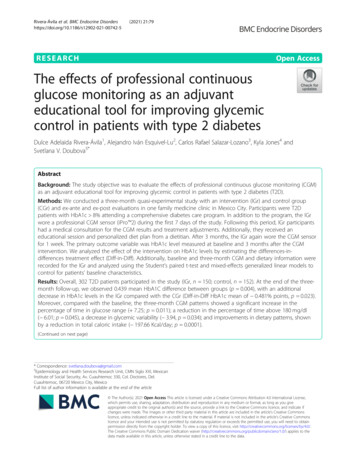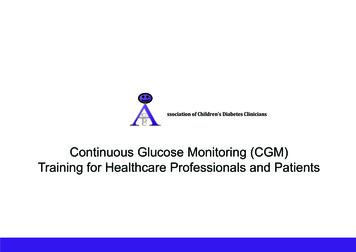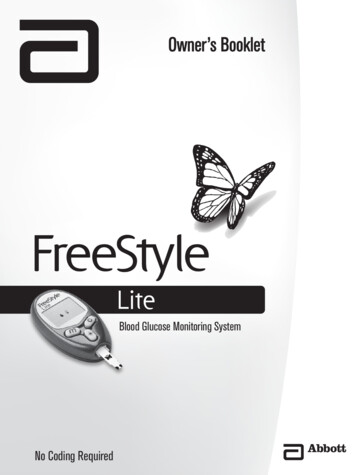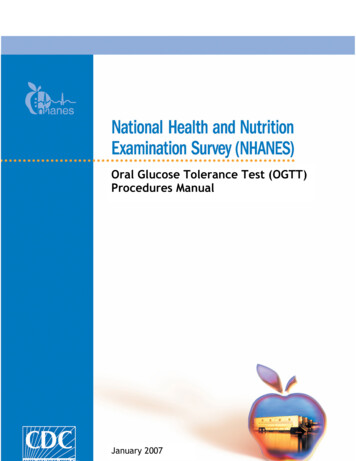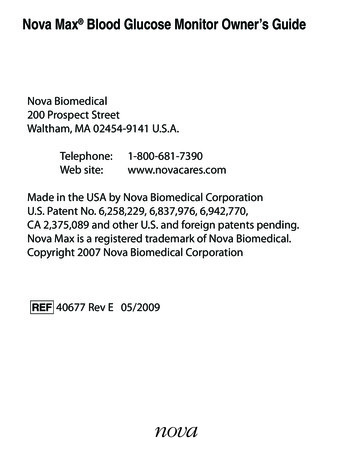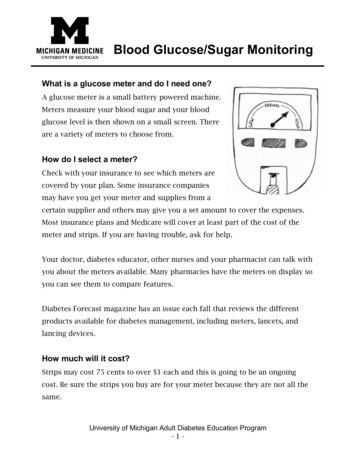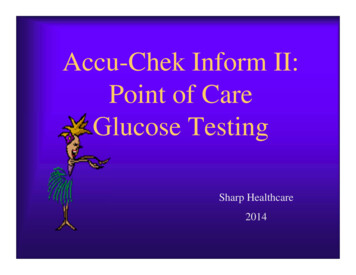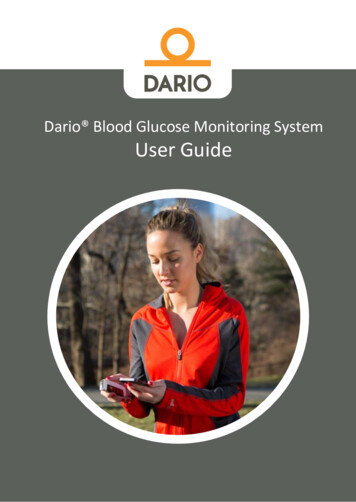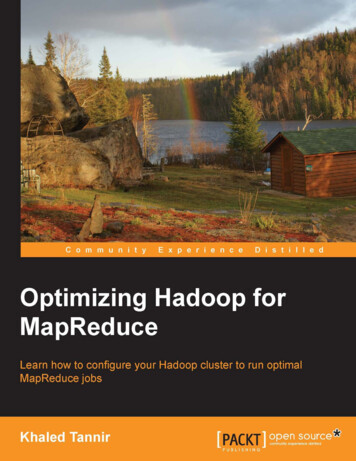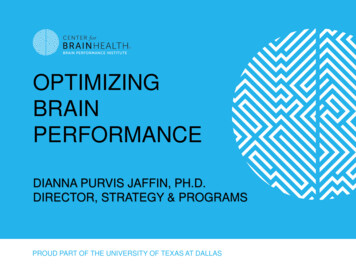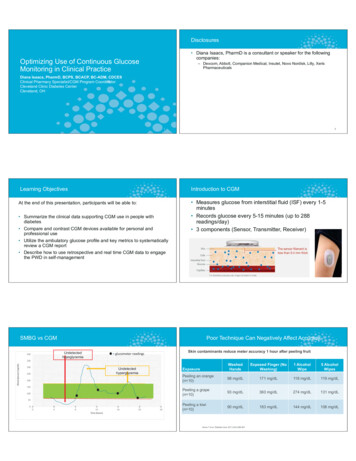
Transcription
Disclosures Diana Isaacs, PharmD is a consultant or speaker for the followingcompanies:Optimizing Use of Continuous GlucoseMonitoring in Clinical Practice‒ Dexcom, Abbott, Companion Medical, Insulet, Novo Nordisk, Lilly, XerisPharmaceuticalsDiana Isaacs, PharmD, BCPS, BCACP, BC-ADM, CDCESClinical Pharmacy Specialist/CGM Program CoordinatorCleveland Clinic Diabetes CenterCleveland, OH1Learning Objectives2Introduction to CGMAt the end of this presentation, participants will be able to: Summarize the clinical data supporting CGM use in people withdiabetes Compare and contrast CGM devices available for personal andprofessional use Utilize the ambulatory glucose profile and key metrics to systematicallyreview a CGM report Describe how to use retrospective and real time CGM data to engagethe PWD in self-management Measures glucose from interstitial fluid (ISF) every 1-5minutes Records glucose every 5-15 minutes (up to 288readings/day) 3 components (Sensor, Transmitter, Receiver)SMBG vs CGMPoor Technique Can Negatively Affect AccuracyUndetectedhypoglycemia glucometer readingsUndetectedhyperglycemiaSkin contaminants reduce meter accuracy 1 hour after peeling fruitWashedHandsExposed Finger (NoWashing)1 AlcoholWipe5 AlcoholWipesPeeling an orange(n 10)98 mg/dL171 mg/dL118 mg/dL119 mg/dLPeeling a grape(n 10)93 mg/dL360 mg/dL274 mg/dL131 mg/dLPeeling a kiwi(n 10)90 mg/dL183 mg/dL144 mg/dL106 mg/dLExposureHirose T et al. Diabetes Care. 2011;34(3):596-597.
Limitations to Hemoglobin A1CHow does exercise affect glucose levels?A. IncreaseB. DecreaseC. No effectD. It depends It is a surrogate marker Based on an average Factors that affect red blood cell turnover can make this inaccurate Anemia, hemoglobinopathies and other conditions may falselyelevate or decrease8Types of CGMAt least 42 factorsaffect glucose!ProfessionalPersonalOwned by the clinicOwned by the patientBlinded and unblinded (real-timefeedback) optionsReal-time feedback or scan for feedback (flashdevice)Short term use (3-14 days)Long term useAlarms for hypo/hyperglycemia in selectdevicesAlarms for hypo/hyperglycemia inselect devicesInsurance coverage for most people with type1 or type 2 diabetesInsurance coverage more limited to type 1diabetes or those on MDI insulinNot compatible with insulin pumpsCompatible with smartphones and insulinpumps with select devicesWright L et al. Diabetes Technology and Therapeutics 2017; ional CGM OptionsLibre ProProfessional CGM ComparisoniPro2G6 ProBlinded vs unblindedMaximum wear timeCalibrationIPro2Blinded6 days3-4 per dayG6 ProBoth10 daysNoneFreestyle LibreProBlinded14 daysNoneDownloading reportsCare between usesCarelinkClean and disinfect transmitterClarityDisposable 1 time useLibreViewDisposable 1 time useMARD (accuracy-the lowerthe better)Alarms for high/low alerts11.05%9%12.3%NoYesNoInterfering substancesAcetaminophenHydroxyureaSalicylic acid and vitamin CADCES Practice Paper. The Diabetes Care and Education Specialist Role in CGM. Available at: -blood-glucose.
CGM Shared Medical Appointments Class time: 60-90 minutes 4-6 patients, 2 clinicians, 1 student Download devicesMeet Derek 48yoM, type 2 DM x 10 years, maxed out on metformin, GLP-1 agonist, SGLT2 inhibitor, sulfonylurea A1C 9-9.5% for 12 months, FBG and pre-dinner SMBG 150mg/dL He agreed to wear a professional CGM for 7 days Show report on the screen and interpret with the PWD’sfood/activity/medication logs PWD learn from each other‒ Discuss “bright spots” and “landmines” Lifestyle/meal planning recommendations Medication adjustments Each PWD gets a printed copy of their report and sent to orderingprovider14Derek was shocked by what happened between breakfast and dinner; he agreed to start insulin.Types of Personal CGMPersonal CGM OptionsFreestyletyle Libre FlashReal-Time CGM (rtCGM) Sensor data transmitted continuouslyto a receiver or display device, whichallows for alerts and alarms to beprovided to the wearer without anyactionIntermittently Scanned CGM (isCGM) Results are available only when thesensor is scanned with a readingdevice; optional real time alerts Full 24-h data can be captured anddownloaded if the sensor is scannedat least every 8 hoursLibre 2Medtronic GuardianConnect or Guardian3Senseonics EversenseDexcom G6Petrie JR et al. Diabetes Care. 2017;40(12):1614-1621.CGM: Real Time DataPersonal CGM ComparisonInsulin pumpintegrationDexcom G6T:Slim X2ReceiveriPhone, Android or iPhone, Android, orreceiverreader10 days14 daysFreestyle Libre 2 Guardian Connect or EversenseGuardian 3NoMedtronic 670G,No770G, 630G(Guardian 3)ReaderiPhone or AndroidiPhone, Android(Guardian Connect)14 days7 days90 days2 hours01 hour01 hour0Up to 2 hours2-424 hours2Clarity, Glooko,TidepoolYesLibreview, TidepoolLibreview,TidepoolYesCarelink, TidepoolNoEversense data managementsystem, GlookoYesHydroxyureaSalicylic acid, vitaminC9.4%NoVitamin ximum weartimeWarm-up timeCalibrationsrequired/dayDownloadingreportsFDA Approved fordosingDrug InteractionsMARD9%Alarms for high/low YesFreestyle Libre 14DayNoYesADCES Practice Paper. The Diabetes Care and Education Specialist Role in CGM. Available at: -blood-glucose. Accessed 11/1/2018
CGM IntegrationAll people with diabetes should wear CGMt:slim Control IQt:slim Basal IQInPen smart penMedtronic 770GTrue or False?Medtronic 670G20Patient Factors and Preferences Are Key in Individualizing CGMDevice SelectionGive PWD a Choice!There is no “one-size-fits-all” approach to technology use inpeople with yLink withMobile bilityAlarms forHigh/LowPredictiveAlertsData SharingInsulinautomationPatientPreferenceSmart deviceintegration21Technology AccessAbby Is Forced to Switch her Technology Meet Abby who is feeling great on her hybridclose loop insulin pump She wears the sensor that is designed for herpump She became 65 and went on Medicare Medicare doesn’t pay for her sensor2324
Guideline Updates Technology section added in 2019What is the Evidence for CGM? Ambulatory glucose profile (AGP) and time inrange discussed as glycemic targets (in additionto A1C) Real-time CGM (rtCGM) and intermittentlyscanned CGM (isCGM) are useful to lower A1Cand/or reduce hypoglycemia in adults who arenot meeting glycemic targets, have hypoglycemiaepisodes, and/or unawareness There is no “one-size-fits-all” approach totechnology use in people with diabetes CGM use requires robust and ongoing diabeteseducation, training, and supportIncreased BG Monitoring Leads to Lower A1C in T1DMDIAMOND Trial: T1DM MDIA1C Treatment Group DifferencesP .001Type1 DMExchangeN 20,555Mean A1c%BaselineWeek 24Beck RW et al., JAMA. 2017;317(4):371-378.DIAMOND Trial-T2DM MDIGreater Benefit with Higher Baseline A1CDIAMOND Trial-T2DM MDIA1c Treatment Group DifferencesBaselineHbA1cP .005Beck RW et al. Ann Intern Med. 2017 Sep 19;167(6):365-37Week 12A1C: 0.6% difference at 24 weeks(N 158)Miller KM et al. Diabetes Care. 2013;36:2009-2014BaselineP .001Week 12P .02Week 24-A1C: 0.3% difference at 24 weeks(N 158)Change in HbA1c From BaselineDifferenceP valueCGM GroupUsual Care Group 7.5%-0.9% (n 79)-0.5% (n 79)0.4%0.02 8.0%-0.9% (n 63)-0.6% (n 57)0.3%0.05 8.5%-1.1% (n 39 )-0.7% (n 39)0.4%0.02 9.0%-1.4% (n 17)-0.7% (n 21)0.7%0.04Beck RW et al. Ann Intern Med. 2017 Sep 19;167(6):365-37
Flash CGM in T1DMFLARE-NL 4 Study¾ The FLAsh monitor Registry in the Netherlands (FLARE-NL) Prospective, randomized controlled trial 241 participants with type 1 diabetes and A1C 7.5%, mean A1C 6.7%¾ Prospective, observational nationwide registry 95 internal medicine and diabetes center N 1365, 16% T2DM¾ Overall average A1c reduction of 0.4% (p 0.001) Baseline A1c 8.5%, reduction of 0.8% (p 0.001)¾ At 12 months decrease in diabetes related hospitalizations from 13.7% to 4.7% (p 0.05),66% reduction¾ 37% of subjects reported they increased their exercise/physical activity¾ 95% reported a better understanding of their glucose fluctuations38% reduction in hypoglycemia19% reduction in hyperglycemiaBolinder, et al. Lancet 2016; 388: 2254–63¾ 59% reduction in work absenteeismDaysFokkert M. et al. BMJ Open Diabetes Research and Care 7, no. 1 (2019).The Role of the DCES in Technology Diabetes technology is associated with improved outcomes, that isenhanced when the person using is knowledgeable and actively engaged Simply wearing the device may not automatically translate into healthbenefits The DCES has the central role in defining and establishing a technology-enabled practice setting that is efficient and sustainable The DCES can serve as the technology champion in their respectivepractices and work to reduce therapeutic inertia while improving healthoutcomes33Isaacs D et al. Diabetes Educ. August 2020.Isaacs D et al. Diabetes Educ. August 2020.CGM Data InterpretationGreenwood DA et al. A. Diabetes Educ. August, 2020.Greenwood DA et al. A. Diabetes Educ. August, 2020.36
Data Management d Mobile AppsGlookoclarity.dexcom.comStandardized CGM Metrics for Clinical CareWhat it DownloadsInsulin pumps (Omnipod, Tandem),Dexcom, Eversense, many glucosemeters, InPenDexcom G6, Clarity, Dexcom Dexcom, InPenFollowLibreLink, LibreLinkUpFreeStyle nic.comTidepooltidepool.orgGuardian Connect, Carelink,Sugar IQ Diabetes AssistantTidepool MobileNumber of Days CGM is worn14 days recommendedMedtronic insulin pump andMedtronic CGMInsulin pumps (Medtronic, Tandem,Omnipod), FreeStyle Libre, Dexcom,Guardian Connect, many glucosemeters, InPenEversense enseInPen InsightsReportNAInPenInPen, DexcomKey Metrics 250mg/dL 180mg/dLLevel 2 HyperglycemiaLevel 1 HyperglycemiaTime above range(TAR)Percentage of Time CGM Is Active 70% of data recommendedMean GlucoseGlucose Management Indicator (GMI)CGM-derived estimate of current A1C levelCoefficient of Variation (CV)Measure of glycemic variability(st. dev/mean)CV 36% is considered acceptable70-180mg/dLIn target range 70 mg/dLLevel 1 Hypoglycemia 54 mg/dLLevel 2 HypoglycemiaTime in range(TIR)Time below range(TBR)Battelino T et al. Diabetes Care. 2019;42(8):1593-1603.CGM-Based Targets for Different PopulationsOlder/High-Risk:T1D & T2DT1D & T2D 250 mg/dL(13.9 mmol/L) 180 mg/dL(10.0 mmol/L)Target Range:70-180 mg/dL(3.9-10.0 mmol/L) 70 mg/dL (3.9 mmol/L) 54 mg/dL (3.0 mmol/L)Target time 5% 250 mg/dL(13.9 mmol/L)Pregnancy:T1DTarget timeTarget time 10% 140 mg/dL(7.8 mmol/L) 25%Target Range:63-140 mg/dL(3.5-7.8 mmol/L) 70% 25% 180 mg/dL(10.0 mmol/L) 50% 70%Target Range:70-180 mg/dL(3.9-10.0 mmol/L) 4% 1% 70 mg/dL (3.9 mmol/L)AGP Report 50% 1% 63 mg/dL (3.5 mmol/L) 54 mg/dL (3.0 mmol/L) 4% 1%1% of the day is 15 minutesCGM continuous glucose monitoring; T1D type 1 diabetes; T2D type 2 diabetes.Battelino T et al. Diabetes Care. 2019;42(8):1593-1603.40AGP ReportCustomizing Reports4142
Time in Range SettingsSnapshot: Hypoglycemia Target range refers to 70 – 180 mg/dL, except for patients who are pregnant Otherwise, interpreting time-in-range and other key metrics is difficult44CGM Data Review- DATAAComparingDifferent Days46Numbers are not Good or BadCase Study: Meet Janet Thank the person for wearing CGM Express that this is information, not good or bad Ask permission to explore the highs 70-years old female Diagnosed with type 2 diabetes18 years ago Retired If the person wants to stop at any point, develop an action plan untilnext visit Married, 3 children, 2grandchildren A1C 10.5% Has arthritis, hoping to get aknee replacement, but needsto bring down A1C BMI 34kg/m2Meds Metformin 1000 mg BID Insulin glargine 60 units daily Insulin lispro 10-20 units TIDat each mealAction Plan in collaboration with the PWD48
Janet Wears Professional CGMWhat is Janet’s time in range goal?A.B.C.D. 50% 70% 80% 100%49DATAA DiscussionNo hypoglycemia, however, glucose falls overnight, Janet feels symptomsDidn’t eat all day Thu and then“went off the wagon”Ate cookies, ice creamRarely taking lispro, never misses glargineAte eggs for breakfast,Sandwich for lunch and sheinjected lispro1 Month Later Time in range improved! Janet is more consistent withlispro (2 injections/day) butasks if there are any othermedications that can helpwith weight and blood sugars GLP-1 agonist is added Janet liked seeing the data She learned the direct effects of food on her blood sugars She realized that she would benefit from taking lispro with her food duringthe day Janet gets a prescription for personal rtCGM Follow-up with the diabetes care and education specialist3 Months Later¾ Time in range improved, 70%!¾ A1C is now 7.1%¾ Janet is eating smallermeals, allows herself 1treat/day, taking lisproconsistently at 2 mainmeals, continues onglargine and GLP-1 agonist(rarely misses doses)¾ She lost 12 lbs, feels great!¾ She is scheduled for hersurgery
In SummaryCGM Revenue OpportunitiesMedicareFeeScheduleCGM ServicesPrivate Payer Clinical data and guidelines support use of CGM in many differenttypes of people with diabetes (PWD)CPT 95249 (Personal CGM - Startup/Training)Ambulatory CGM of interstitial tissue fluid via a subcutaneous sensor for a minimum of 72 hours; patientprovided equipment, sensor placement, hook-up, calibration of monitor, patient training, and printout ofrecording. 55.58 127 152.66 303304 36.81 96 There are multiple CGM options and connected devices; one sizedoes not fit allBill only once during the time period that the patient owns the device.CPT 95250 (Professional CGM)Ambulatory CGM of interstitial tissue fluid via a subcutaneous sensor for a minimum of 72 hours; physician orother qualified health care professional (office) provided equipment, sensor placement, hook-up, calibration ofmonitor, patient training, removal of sensor, and printout of recording. Retrospective and real time CGM data can engage the PWD in selfmanagementDo not bill more than 1x/month.CPT 95251 (CGM Interpretation)Ambulatory CGM of interstitial tissue fluid via a subcutaneous sensor for a minimum of 72 hours; analysis,interpretation and report.Do not bill more than 1x/month Review CGM in 5 steps:‒ Download, assess safety, time in range, areas to improve, action plan1Medicare*Non-facility is defined as office space.outpatient clinic visits.CGM continuous glucose monitoring.Dexcom. 2020 CGM Coding Reference. https://dexcompdf.s3-us-west-2.amazonaws.com/HCP Website/Telehealth Resources/CodingReimbursement Updates-2020-4.pdf accessed 9/24/2056Resources Diabetes Advanced Network Access (DANAtech) https://www.danatech.org/ Association of Diabetes Care & Education Specialists (ADCES) Glucosemonitoring resources -blood-glucose DiaTribe: https://diatribe.org/ Eversense: https://eversensediabetes.com Medtronic Guardian Connect: ect Dexcom G6: https://www.dexcom.com/g6-cgm-system Freestyle Libre: https://www.freestylelibre.us/THANK YOU
Dexcom G6 Freestyle Libre 14 Day Freestyle Libre 2 Guardian Connect or Guardian 3 Eversense Insulin pump integration T:Slim X2 No No Medtronic 670G, 770G, 630G (Guardian 3) No Receiver iPhone, Android or receiver iPhone, Android, or reader Reader iPhone or Android (Guardian Co
